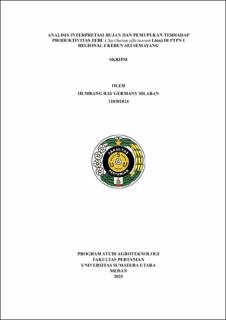Analisis Interpretasi Hujan dan Pemupukan Terhadap Produktivitas Tebu ( Saccharum Officinarum Linn) Di PTPN I Regional 1 Kebun Sei Semayang
Abstract
Sugarcane is a crucial plantation commodity in Indonesia, especially for the sugar industry. Its productivity is significantly influenced by various factors, such as rainfall and fertilization. This study aims to examine and analyze the effects of rainfall, rainy days, and N, P, K fertilization on sugarcane productivity. The research was conducted at Sei Semayang Plantation, PTPN I, located in Sunggal Subdistrict, Deli Serdang Regency, North Sumatra, starting in January 2025 until completion. The research hypothesis states that rainfall, rainy days, and fertilization significantly influence the productivity of sugarcane ( Saccharum officinarum Linn) at PTPN I Sei Semayang Plantation. This study uses secondary data available from the plantation office administration, including monthly rainfall and rainy day data from 2019–2023, fertilization data from milling years 2020–2024, and sugarcane productivity data across planting stages: PC, RCI, RCII, and RCIII. The analytical methods employed are multiple linear regression and correlation analysis. Model validity was tested using classical assumption tests, including normality, heteroskedasticity, multicollinearity, and autocorrelation tests, with SPSS v.25 for Windows as the supporting tool. Data were analyzed based on planting stages. Annual rainfall in the range of 1800–2500 mm/year positively influenced sugarcane productivity, especially at PC to RCII stages. Rainy days had a negative effect on PC and RCI stages but began to show a positive influence at RCII and RCIII. In terms of fertilization, Urea had a negative effect on productivity, with significant impact particularly at RCII, possibly due to nitrogen excess disrupting nutrient balance. TSP and KCl showed varied effects depending on dosage and plant stage
Collections
- Undergraduate Theses [3569]

